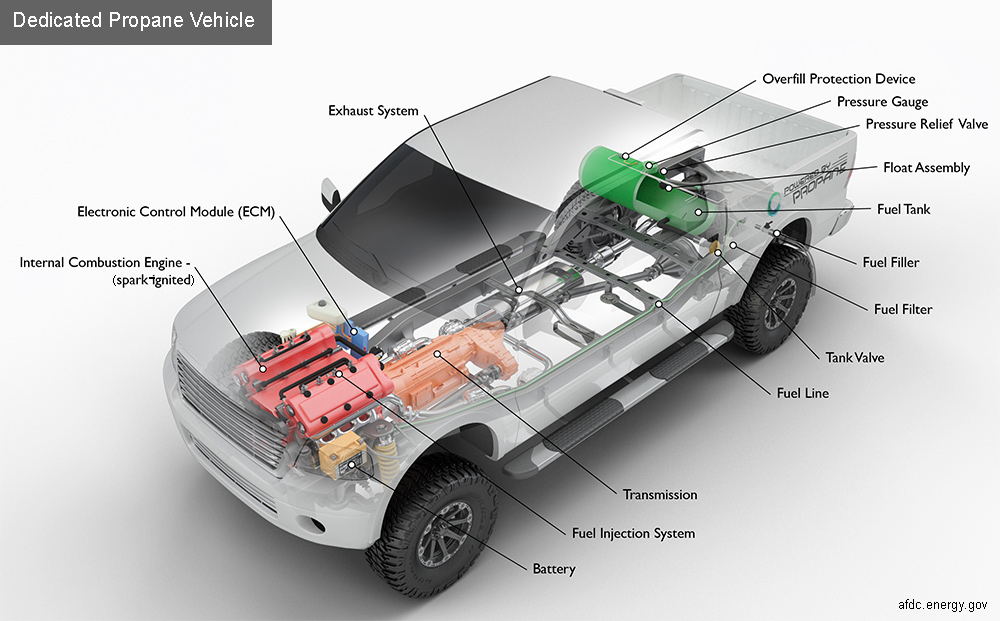PROPANE
Propane Basics
Propane powers about 190,000 vehicles in the United States and more than 14 million worldwide.1 Propane vehicles are a good choice for many fleet applications, including school buses, shuttle buses, taxis and light-duty trucks. The advantages of propane as an alternative fuel include its domestic availability, performance, safety, and clean-burning qualities.
What is propane?
Also known as liquefied petroleum gas (LPG), propane is an oderless, nontoxic hydrocarbon, gas at normal pressures and temperatures. When pressurized, it is a liquid with an energy density 270 times greater than its gaseous form. A gallon of liquid propane has about 25% less engery than a gallon of gasoline.
Fuel Facts
Propane is a clean-burning, domestically produced alternative fuel that can power light-, medium-, and heavy-duty vehicles. The fuel is a colorless, odorless liquid that is stored under pressure. An odorant, ethyl mercaptan, is added to the fuel for leak detection. Propane is also known as liquefied petroleum gas or liquefied propane gas (LPG), or propane autogas. In the United States, these terms are used interchangeably.
Vehicle Types
Propane vehicles work much like spark-ignited gasoline vehicles. The fuel is stored as a liquid in a relatively low-pressure tank (about 150 pounds per square inch). There are two types of propane fuel systems:
- Vapor-Injected Systems: Liquid propane travels along a fuel line into the engine compartment. The supply of propane to the engine is controlled by a regulator or vaporizer, which converts the liquid propane to a vapor. The vapor is then fed to a mixer located near the intake manifold where it is metered and mixed with filtered air before being drawn into the combustion chamber and burned to produce power, similar to gasoline. An example is the Alliance AutoGas Prins bi-fuel system.
- Liquid Propane Injection Systems: Propane is not vaporized. Instead, it is injected into the combustion chamber in liquid form. Examples are the CleanFUEL USA and Roush CleanTech technologies.
Propane vehicles are available in the following configurations:
- Dedicated Vehicle: These vehicles are designed to run on only propane and are used in light-, medium-, and heavy-duty applications.
- Bi-Fuel Vehicle: These vehicles are able to run on either propane or gasoline because they have two separate fueling systems. Bi-fuel vehicles include light-duty models and, more recently, medium- and heavy-duty vehicles.
◦ Please note that some agencies may use the term dual-fuel to describe bi-fuel vehicles. However, Clean Cities uses dual-fuel to describe vehicles that have fuel systems that run on alternative fuel and use diesel fuel for ignition assistance. By this definition, there are not currently any dual-fuel propane systems available.
The power, acceleration, and cruising speed of propane vehicles, whether they are dedicated or bi-fuel, are comparable to those of gasoline vehicles.
Fueling Infrastructure Components
Propane fueling infrastructure is very similar to gasoline equipment, including:
Storage Tank: Propane is brought to the station via a transport truck and put into on-site storage—traditionally an aboveground storage tank on a concrete pad.
- Pump and Fuel Dispenser: The main difference between a propane fueling dispenser and a gasoline dispenser is that propane is delivered to the vehicle under pressure so it remains a liquid. When the vehicle tank is full, the dispenser stops automatically just like a gasoline dispenser.
- Credit Card Reader: A card reader is necessary for a public station accepting payment. Note that federal regulations require a “competent attendant” to fuel propane vehicles, so drivers may need to be trained before they can use an unmanned pump (Title 29 of the Code of Federal Regulations, section 1910.110; National Fire Protection Association (NFPA) 58 and 54).
Fueling stations may fall into one of the following categories:
- Skid-Mounted: The storage tank, dispenser, pump, and any additional piping or controls are mounted to a portable concrete or steel frame that can be installed easily, removed, or relocated. Skid-mounted systems tend to be more affordable than stationary equipment.
- Stationary: In a stationary system, the storage tank may be underground, and the station may include additional features not available on a skid-mounted system, including spill-proof pumps and additional metering capabilities.
More information on propane vehicles and infrastructure can be found on the Alternative Fuels Data Center (AFDC) Propane website and the Propane Education & Research Council website.
Propane Fueling Stations Locator


